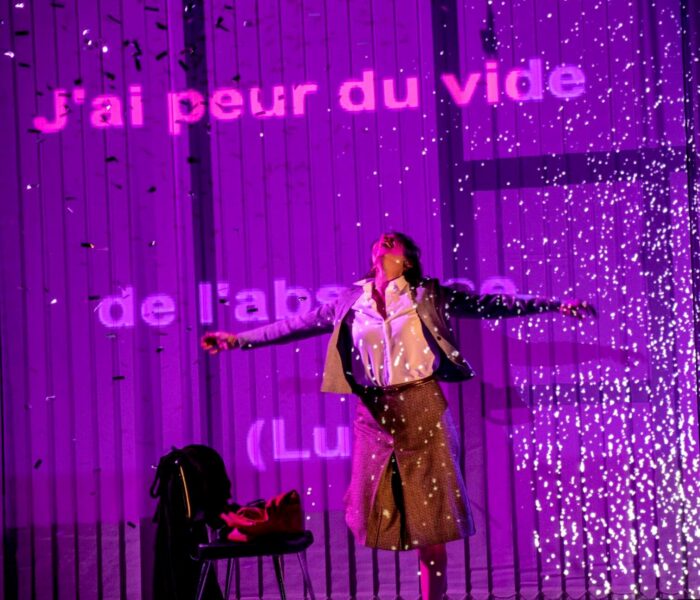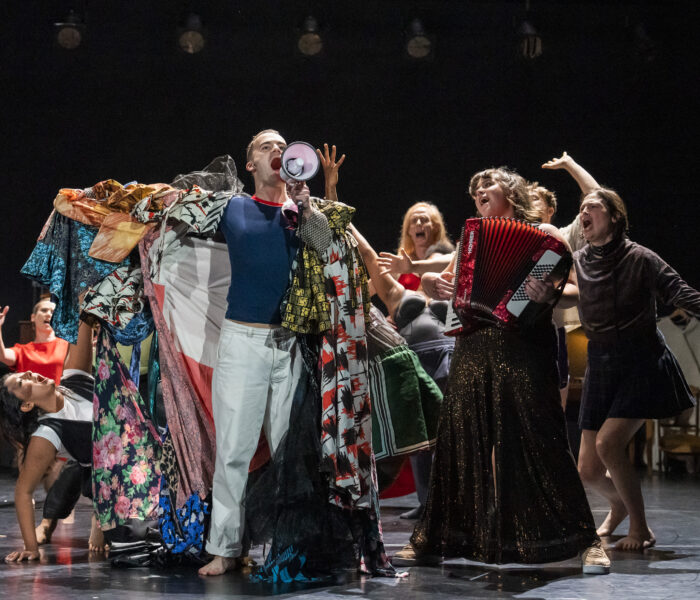Wozzeck d’Alban Berg fait son entrée au répertoire du Festival d’Aix-en-Provence qui fête quant à lui ses 75 ans d’existence. L’ouvrage est donné au Grand Théâtre de Provence dans une nouvelle production signée Simon McBurney avec en fosse le London Symphony Orchestra (LSO) sous la direction de Sir Simon Rattle.
Long est le chemin qui relie la pièce de théâtre fragmentaire de Georg Büchner (1813-1837), écrite aux premières heures de la révolution industrielle du XIXᵉ siècle, à l’opéra d’Alban Berg créé en 1925. Emporté par le typhus à l’âge de 24 ans, Büchner laisse un manuscrit où l’ordre des scènes n’a pas été fixé ainsi que deux esquisses du drame offrant des différences sensibles. S’appuyant sur l’édition critique de l’oeuvre intégrale de Büchner que fait paraître Karl Emil Franzos, Paul Landau publie en 1910 une nouvelle version du texte, sous le titre de Wozzeck (au lieu de Woyzeck) à partir de laquelle Berg, qui assiste à la création viennoise de la pièce en 1914, va écrire son propre livret. Il emprunte pour ce faire le modèle de la tragédie antique articulant le drame selon trois phases successives, Exposition, Péripétie et Catastrophe, vécues à travers le prisme de la psyché tourmentée du soldat Wozzeck. La composition qui débute en 1917, est interrompue durant les années de guerre (Berg est envoyé faire ses classes d’officier en basse Autriche) dont l’expérience traumatisante rejaillit dans l’écriture. L’opéra est créé en 1925 au Staatsoper de Berlin sous la baguette d’Erich Kleiber à l’issue de… 130 répétitions!
L’histoire, inspirée d’un fait divers, est celle d’un brave soldat, Wozzeck, qui vit en union libre avec sa compagne Marie dont il a eu un enfant. Victime d’hallucinations, il est la proie de son entourage, méprisé par ses supérieurs – un Capitaine et un Docteur à l’ironie bestiale – et trompé par Marie qui se laisse séduire par le Tambour-major. Dévoré par la jalousie et emporté par ses pulsions morbides, il tue sa maîtresse avant de mourir noyé dans le marais où il est allé rechercher le couteau du crime…
Noirceur et désespérance
Le plateau est plongé dans l’obscurité durant les minutes qui précèdent l’impact sonore du début. Se tiennent au garde-à-vous des militaires avec leur casque, dans une attente silencieuse que viennent troubler les aboiements lointains d’un chien. Des formes en noir et blanc sur les parois latérales ajoutent à l’étrangeté du tableau. Du groupe de soldats se détache Wozzeck. Il est avec son capitaine dans une première scène où il subit ses invectives (« Wozzeck a toujours l’air d’un possédé », serine le militaire en uniforme). La présence d’un capitaine junior mimant les gestes de son aîné intrigue! Étrange également et saisissante est cette deuxième scène très réussie avec l’ami Andres où l’on voit des hommes attelés à des perches de bois qui s’effondrent sur le sol tandis que Wozzeck médite sur le caractère inquiétant de l’endroit : « Du feu! Du feu! L’espace s’embrase sous les effets des lumières (Paul Anderson) et de la vidéo (Will Duke).
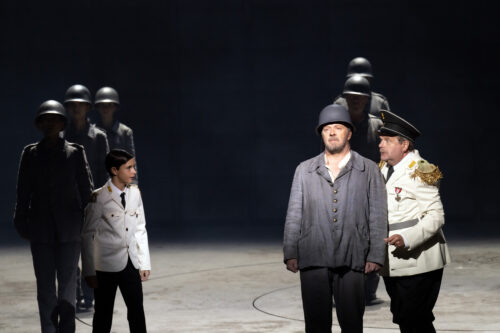

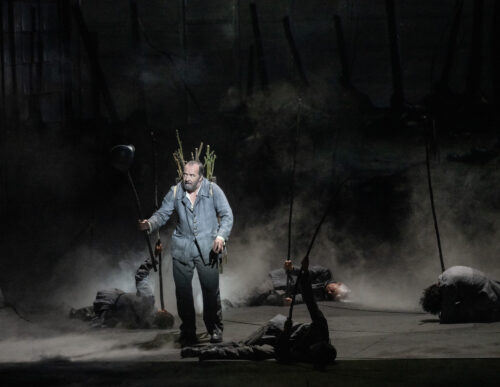
Autant que l’intériorité tourmentée du personnage, c’est la dimension politique et militaire qui est soulignée dans la mise en scène très fouillée de McBurney. D’une stature impressionnante, Christian Gerhaher incarne un Wozzeck sombre et désespéré, souvent le dos voûté, pitoyable même quand il arrive chez Marie. Avec son fagot de bois sur le dos et hanté par les images qui le traversent, il parle avec elle dans une courte scène où s’exprime à l’évidence l’incommunicabilité des deux êtres. Avec son enfant (Thomasz Kumiega) qu’elle repousse autant qu’elle chérit, Marie est installée à même le sol sur un plateau dont une équipe de régisseurs modifie en live la configuration à chaque nouvelle scène. Wozzeck, quant à lui, est constamment présent, que se soit sur la triple tournette installée au centre de l’espace ou encore derrière la porte (autre élément de décor important), isolé de la foule, où il voit danser Marie avec le Tambour-major.
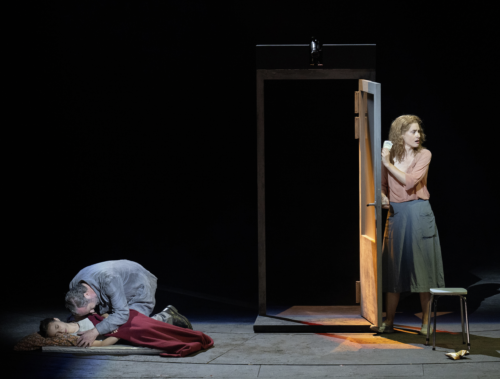
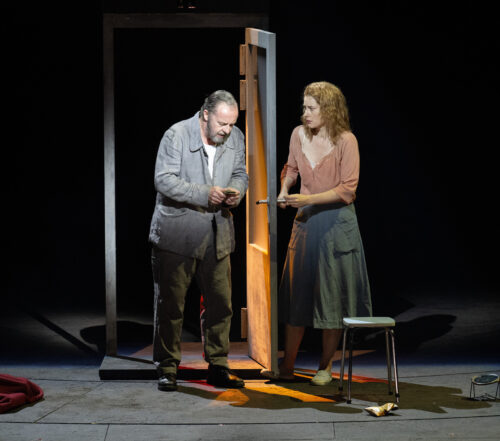

Intelligence et passion
Au sein d’un orchestre très fourni où la percussion (le xylophone en particulier) fait entendre ses signaux prémonitoires, passent les Leitmotive (motifs conducteurs) attribués à chaque personnage : le hautbois pervers du Capitaine, le violoncelle insidieux du Docteur, etc. Ils jouent un rôle essentiel dans le déroulement dramaturgique, clairement dessinés à travers la lecture analytique qu’en offre Sir Simon Rattle à la tête d’un LSO rutilant. Jamais encore les arcanes de l’écriture bergienne, les fondements structurels de l’œuvre empruntés aux formes classiques de la musique, n’avaient été à ce point sondées et entendues, sans pour autant freiner le flux dramaturgique : rythmique pointilleuse, conduite métrique élégante et transparence des textures. Les couleurs sont somptueuses, distribuées à tous les pupitres, y compris celle du tuba, très en verve dans la musique de scène de l’acte II (où les musiciens côtoient les chanteurs) et celle du Cabaret (qu’on entend plus que l’on ne voit) dont les sonorités chancellent à l’image d’un Wozzeck qui a du sang sur les mains. La prière de Marie (les mots de la Bible s’affichent sur les murs) confine à l’émotion, jouée avec une grande délicatesse au début de l’acte III où Berg tisse une fugue entre la voix de la soprano et les cordes de l’orchestre. Rattle redouble le soin et l’expressivité des lignes dans les merveilleux interludes reliant les scènes au sein des trois actes. Le dernier est une révérence bergienne à cet autre maître Gustav Mahler, l’ultime vision d’un monde finissant alors que Wozzeck disparaît lentement dans les profondeurs du marais, l’une des pages les plus envoûtantes de la soirée.
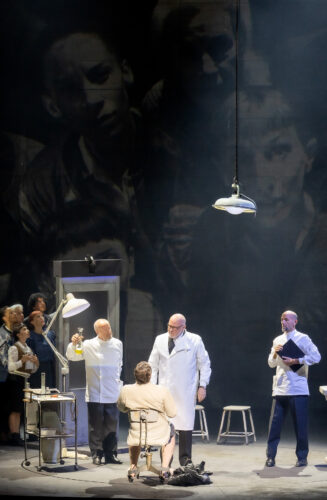

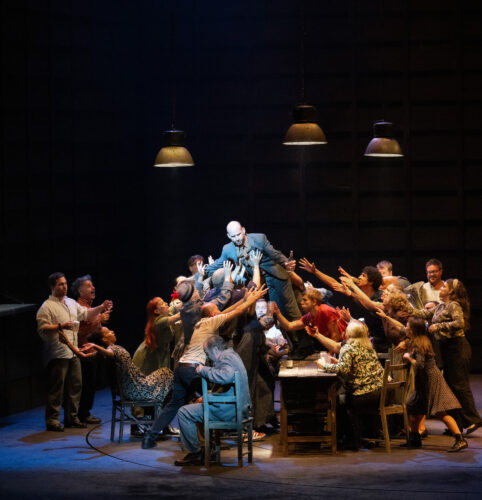
Une distribution de haut vol
Les voix magnifiquement timbrées assument toutes, et avec une virtuosité insolente, les escarpements de la ligne mélodique, du parlé-chanté à l’arioso et jusqu’au bel canto de Marie. Un rien monolithique dans sa posture d’anti-héros, Christian Gerhaher n’en est pas moins impressionnant, dont le potentiel vocal semble infini, du grain sombre de son registre de baryton aux extensions sans limite dans les aigus. Les mêmes qualités s’entendent chez les deux bourreaux, le baryton large de Brindley Sherratt (Doktor) et le ténor perçant de Peter Hoare (Hauptmann). Avec sa veste rouge, le Tambour-Major Thomas Blondelle (« comme un taureau par le torse », nous dit Marie) est clair et offensif à souhait. Entre révolte et tendresse maternelle, inquiétude et désespérance, la voix aussi flexible que séduisante de la soprano suédoise Malin Byström (Marie) nous émeut, conférant tout à la fois fragilité et sensualité à son personnage. Moins sollicités, la soprano Héloïse Mas (Margret) et le ténor Robert Lewis (Andres) sont tout aussi vaillants et convaincants. Le chœur d’hommes est estonien (Philharmonic Chamber Choir), beau à faire pleurer les pierres dans cet instant trop court (scène 5 de l’acte II) où les voix d’hommes fondues deviennent rumeur, comme un souffle fantomatique et fantastique qui emplit l’espace.
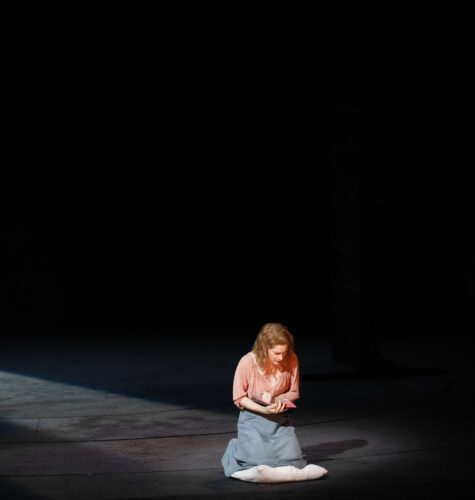
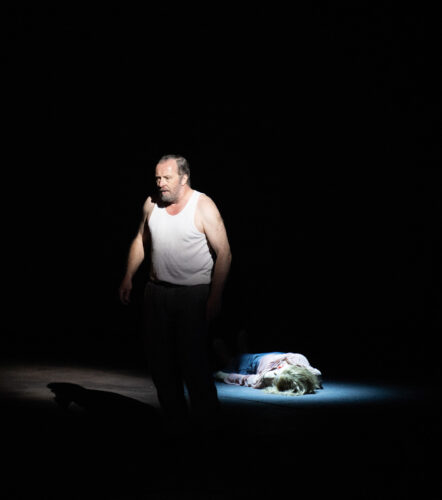
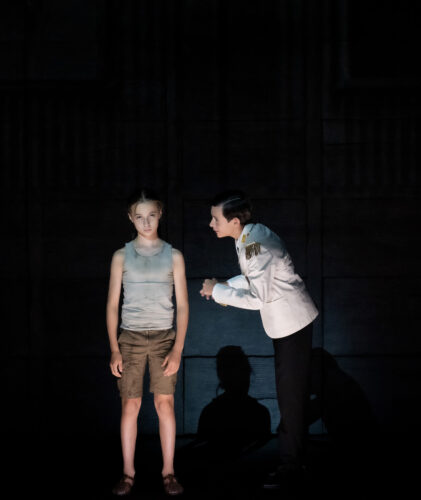
« L’enfant de Marie joue au cheval sur un bâton », nous disent les didascalies du livret de Berg dans l’ultime scène, ô combien déchirante, de l’opéra. Dans la mise en scène de McBurney, c’est le capitaine junior, réapparaissant dans son uniforme blanc et sa caquette de militaire, qui articule à sa place les Hop! Hop!, laissant l’enfant mutique et figé dans son corps jusqu’à l’extinction des lumières : c’est le tour du pauvre petit…
Michèle Tosi
Festival d’Aix-en Provence, Grand Théâtre de Provence le 10-07-2023
Alban Berg (1885-1935) : Wozzeck, opéra en trois actes d’après le drame Woyzeck de Georg Büchner ; livret d’Alban Berg ; mise en scène Simon McBurney ; scénographie, Miriam Buether ; costumes, Christina Cunningham ; lumière, Paul Anderson ; chorégraphie, collaboration à la mise en scène, Leah Hausman ; vidéo, Will Duke ; dramaturgie, Gerard McBurney. Wozzeck, Christian Gerhaher ; Marie, Malin Byström ; Le Tambour-major, Thomas Blondelle ; Doktor, Brindley Sherratt ; Hauptmann, Der Narr, Peter Hoare ; Andres, Robert Lewis ; Margret, Héloïse Mas ; Handwerksbursch 1, Matthieu Toulouse ; Handwerksbursch 2 ; Tomasz Kumiega ; L’enfant de Marie, Lenny Bardet ; un Soldat, Danila Frantou. Chœur Estonian Philharmonic Chamber Choir ; chef de chant, Lodewijk van der Ree ; maîtrise des Bouches-du-Rhône ; chef de chœur Samuel Coquard ; London Symphony Orchestra ; direction Sir Simon Rattle.
Photos © Monika Ritterhaus



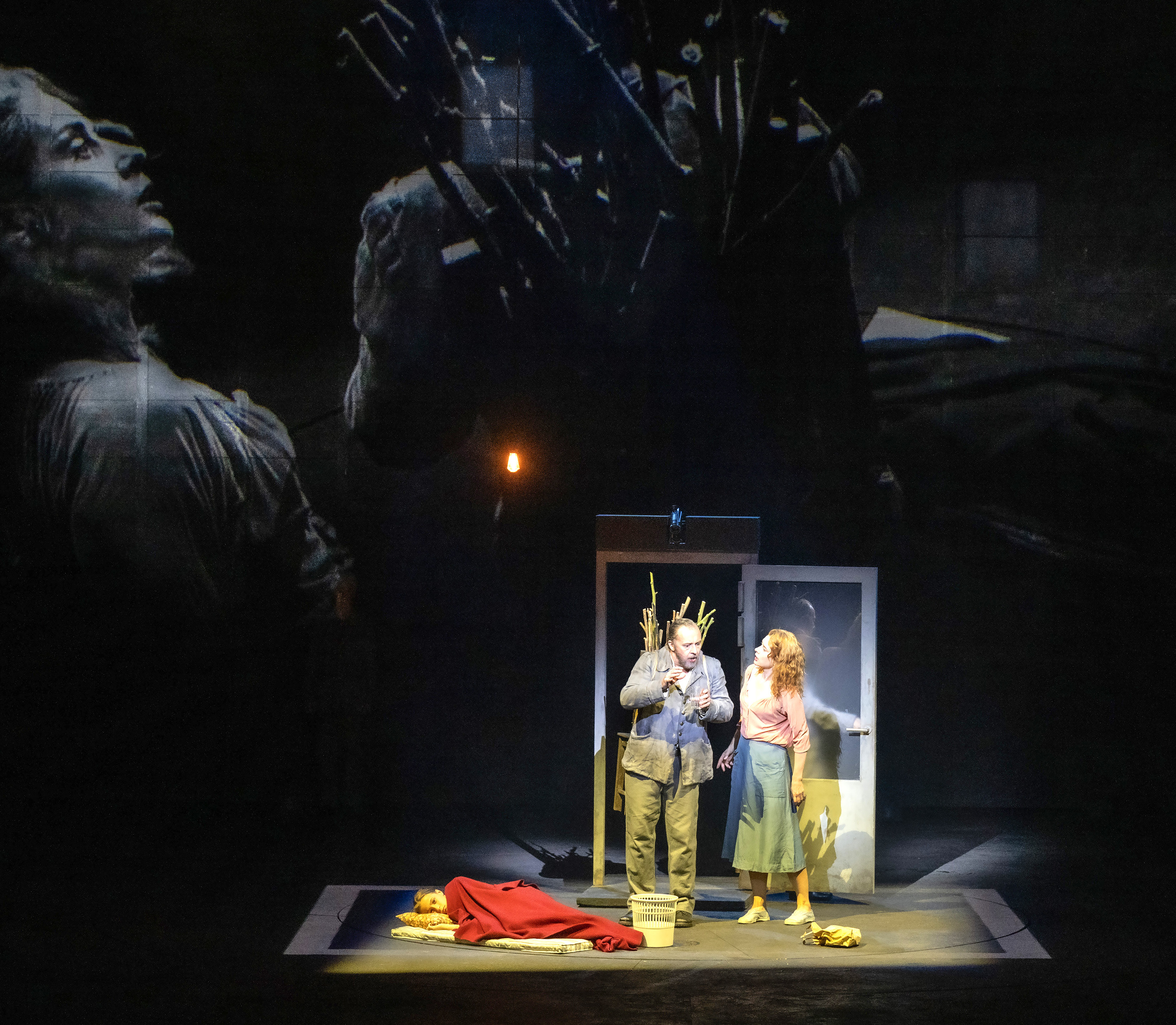)
